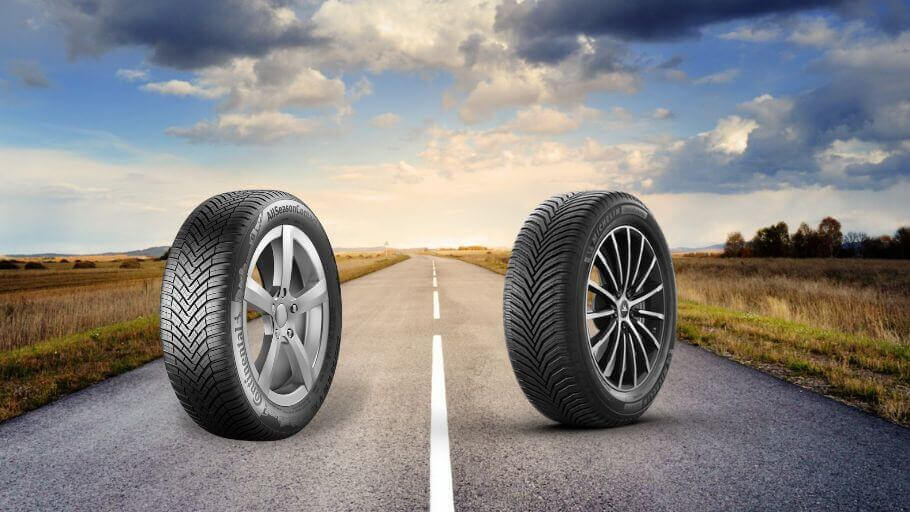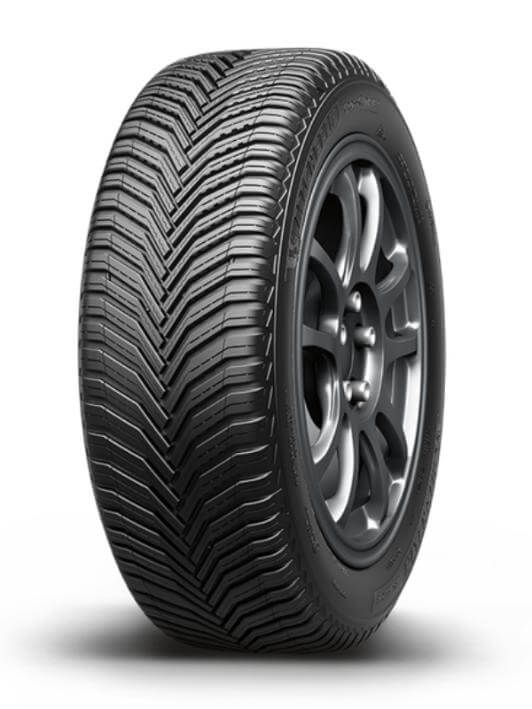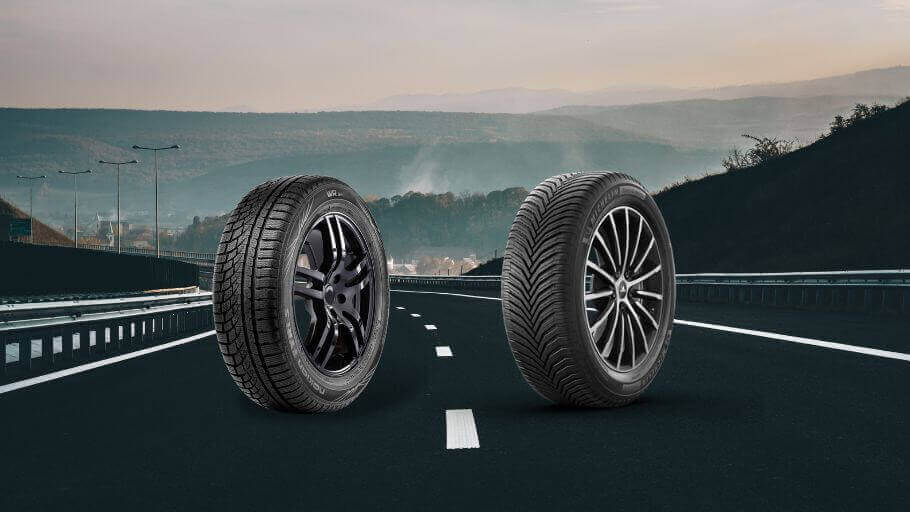With so many winter-rated all-season tires available, it can be hard to know which ones are the best. To face Canadian weather conditions year-round, you need tires that are truly versatile!
Blackcircles is here to help you with this head-to-head matchup between the Continental All Season Contact vs. the Michelin Crossclimate 2. Discover which one is right for you and find the best prices on your next set.
Comparing the Continental All Season Contact vs Michelin Crossclimate 2
The Continental All Season Contact vs. Michelin Crossclimate 2 both belong to the same category: they are 4-season tires approved for winter use. This means that, unlike other all-season tires, you can drive with them in winter conditions. In Quebec, it also means that you won't have to change your tires: they are street legal all year long.
On one side we have the Continental All Season Contact which is available in sizes from 14 to 20 inches and is designed primarily for passenger cars.
The other is the Michelin Crossclimate 2, which is available in sizes ranging from 16 to 22 inches and is suitable for cars, SUVs, minivans and performance vehicles. Note that the Crossclimate has been discontinued and replaced by the Crossclimate 2, which is available in up to 40% more sizes than its predecessor.
The Michelin tire has H and V speed ratings, while the Continental tire is rated for T, H and V. While the French brand's tire is suitable for a wider range of cars, both brands offer an excellent model that performs well in summer and winter and delivers a safe ride on the road.
Specs of the Continental All Season Contact
The German brand offers a tire that handles "the road with serenity", delivering balanced driving experience all year round. To achieve this, it relies on several features, including:
- Directional tread pattern
- High-silica compound
- Wide shoulder grooves
- Rigid blocks with fine siping
- Optimized sidewall geometry

What exactly does this mean? First, for the tread design, Continental drew inspiration from one of its best winter tires, the WinterContact TS. The directional design features a V-pattern that is nevertheless a little less aggressive than that of the winter tire.
This design allows the tire to drain water and slush more efficiently, as well as water that could be present on an icy surface. These grooves widen at the shoulder to promote even better evacuation and reduce the risk of hydroplaning.
The tire also features rigid blocks with fine sipes: these are primarily intended to maximize braking and handling on dry roads.
But what about their winter performance? The brand boasts a flexible tread compound that can withstand the cold, making it safe and effective in all conditions. The blend of resins and the high concentration of silica in the compound, called the "Traction Silica Compound" are the secret to the tire's winter performance.
The sidewall geometry is coupled with a deep tread design that reduces rolling resistance to give you a more fuel-efficient tire. This is how Continental creates a tire that combines winter and summer tires, making it the ideal tire for all seasons.
Specs of the Michelin Crossclimate 2
As we mentioned, the Crossclimate 2 is the successor to the Crossclimate, offering a wider range of sizes. This all-season tire boasts features such as:
- Directional tread design
- Pronounced V-pattern
- Thermal adaptive compound
- 3-D SipeLock technology
One reason why the Michelin tire gives such a reliable all-season performance is its design, which is engineered to drain water efficiently. Its directional line with particularly aggressive V-grooves quickly directs water and slush away from the tire. This results in exceptional resistance to aquaplaning in both summer and winter.
Speaking of winter, the rubber compound of the Crossclimate was designed to adapt to all climates. That's why it's called thermoadaptive. It remains flexible even when the temperature drops and delivers a reliable and safe performance when the temperature rises.
What's more, this compound delivers outstanding durability despite its ability to withstand higher temperatures. At Michelin, tire durability is a priority, and the manufacturer is putting in the work with its all-season tire, which boasts a longer life than many rivals.
The SipeLock 3-D siping technology is another excellent Michelin technology for winter performance. These sipes are equipped with biting edges for increased traction on snow and ice.
The Michelin Crossclimate 2 is designed for all-season performance. Continue reading to learn all about the performance of the Continental All Season Contact vs. the Michelin Crossclimate 2.
Choosing between the Continental All Season Contact vs the Michelin Crossclimate 2
These 4-season tires have both been tested by many experts. This includes the 2021 Tyre Reviews tests, which brought the two models face to face. This allows us to compare them in a very objective way.

Let's begin with the strengths of the Continental tire: it delivered shorter braking distances on cold dry pavement as well as on snow. Both tires also showed good handling on snowy, wet and dry roads.
Both tires are also neck and neck in terms of riding comfort and cornering in hydroplaning situations; in fact, they both rely on directional tread designs.
However, the Michelin tire outshines its competitor in several areas:
- Braking on wet roads
- Braking on dry pavement (warm temperatures)
- Traction on snow
- Rolling resistance
While the braking power on dry roads of the All-Season Contact is powerful in cold weather, the Crossclimate stops in 1.1 meters earlier when the temperature is a little warmer. And on wet roads, it does so in 3.1 meters less!
We can see that the SipeLock siping technology does its job well when it comes to driving on snowy surfaces, because the Michelin tire offers superior traction on snow.
It's not for nothing that the Crossclimate 2 is repeatedly ranked as one of the best in its category, especially by experts like those at the Auto Guide and Auto123.
Also very important is its low rolling resistance, which makes it a good choice for fuel economy and durability. All in all, the Continental tire is a very good tire, but Michelin outperforms it in many ways.
It is not surprising that the comparison of the Continental All Season Contact vs. the Michelin Crossclimate 2 shows that the French brand enjoys clear advantage, since it is a more premium tire with higher prices.
Comparing Warranties
With both Michelin and Continental, you will enjoy exceptional warranties. With Michelin, you benefit from a 6-year limited warranty from the date of manufacture as well as a 100,000 km mileage warranty.
With Continental, you receive a 72-month limited warranty from the date of purchase, with a free replacement within the first 12 months. Both brands also go above and beyond their competitors with a 60-day satisfaction guarantee and 3-year roadside assistance!
Check out the table below to see how both models compare:
| Features | Continental All Season Contact | Michelin Crossclimate 2 |
|---|---|---|
| Seasons | 4-season approved for Winter driving | |
| Tread pattern | Directional | |
| Vehicles | Passenger Cars | Passenger cars, SUVs, minivans, performance cars |
| Satisfaction Guarantee | 60 days | |
| Roadside assistance |
|
|
| Features | Continental All Season Contact |
|---|---|
| Seasons | 4-season approved for Winter driving |
| Tread pattern | Directional |
| Vehicles | Passenger Cars |
| Satisfaction Guarantee | 60 days |
| Roadside assistance |
|
| Features | Michelin Crossclimate 2 |
|---|---|
| Seasons | 4-season approved for Winter driving |
| Tread pattern | Directional |
| Vehicles | Passenger cars, SUVs, minivans, performance cars |
| Satisfaction Guarantee | 60 days |
| Roadside assistance |
|
Find the Michelin Crossclimate 2 tire and many Continental tire models at the best prices at blackcircles! With blackcircles, you always get a good deal on the best tire brands.








